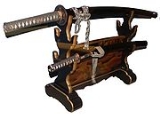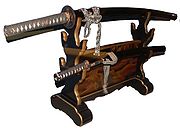
Daisho
Encyclopedia
The is a Japanese
term for a matched pair of traditionally made Japanese swords (nihonto) worn by the samurai
class in feudal Japan.
and wakizashi
mounted in matching koshirae but originally the daishō was the wearing of any long and short uchigatana
together. The katana/wakizashi pairing is not the only daishō combination as generally any longer sword paired with a tantō
is considered to be a daishō. Daishō eventually came to mean two swords having a matched set of fittings. A daishō could also have matching blades made by the same swordsmith, but this was in fact uncommon and not necessary for two swords to be considered to be a daishō, as it would have been more expensive for a samurai.
 The concept of the daisho originated with the pairing of a short sword with whatever long sword was being worn during a particular time period. It has been noted that the tachi
The concept of the daisho originated with the pairing of a short sword with whatever long sword was being worn during a particular time period. It has been noted that the tachi
would be paired with a tanto
, and later the uchigatana
would be paired with another shorter uchigatana. With the advent of the katana
, the wakizashi
eventually was chosen by samurai as the short sword over the tanto
. Kanzan Satō in his book titled "The Japanese Sword" notes that there did not seem to be any particular need for the wakizashi and suggests that the wakizashi may have become more popular than the tanto due to the wakizashi being more suited for indoor fighting. He mentions the custom of leaving the katana at the door of a castle or palace when entering while continuing to wear the wakizashi inside.
The wearing of daishō was limited to the samurai
class, and became a symbol or badge of their rank.Daishō may have became popular around the end of the Muromachi period
(1336 to 1573) as several early examples date from the late sixteenth century.An edict in 1629 defining the duties of a samurai required the wearing of a daishō when on official duty. During the Meiji period
an edict was passed in 1871 abolishing the requirement of the wearing of daishō by samurai, and in 1876 the wearing of swords in public by most of Japan's population was banned; this ended the use of the daishō as the symbol of the samurai, and the samurai class was abolished soon after the sword ban.
Japanese language
is a language spoken by over 130 million people in Japan and in Japanese emigrant communities. It is a member of the Japonic language family, which has a number of proposed relationships with other languages, none of which has gained wide acceptance among historical linguists .Japanese is an...
term for a matched pair of traditionally made Japanese swords (nihonto) worn by the samurai
Samurai
is the term for the military nobility of pre-industrial Japan. According to translator William Scott Wilson: "In Chinese, the character 侍 was originally a verb meaning to wait upon or accompany a person in the upper ranks of society, and this is also true of the original term in Japanese, saburau...
class in feudal Japan.
Description
The etymology of the word daishō becomes apparent when the terms daitō, meaning long sword, and shōtō, meaning short sword, are used; daitō + shōtō = daishō. A daishō is typically depicted as a katanaKatana
A Japanese sword, or , is one of the traditional bladed weapons of Japan. There are several types of Japanese swords, according to size, field of application and method of manufacture.-Description:...
and wakizashi
Wakizashi
The is one of the traditional Japanese swords worn by the samurai class in feudal Japan.-Description:...
mounted in matching koshirae but originally the daishō was the wearing of any long and short uchigatana
Uchigatana
The is one type type of traditional Japanese sword worn by the samurai class of feudal Japan. The uchigatana was the descendant of the tachi.-History:...
together. The katana/wakizashi pairing is not the only daishō combination as generally any longer sword paired with a tantō
Tanto
A is one of the traditional Japanese swords that were worn by the samurai class of feudal Japan. The tantō dates to the Heian period, when it was mainly used as a weapon but evolved in design over the years to become more ornate...
is considered to be a daishō. Daishō eventually came to mean two swords having a matched set of fittings. A daishō could also have matching blades made by the same swordsmith, but this was in fact uncommon and not necessary for two swords to be considered to be a daishō, as it would have been more expensive for a samurai.
History

Tachi
The is one type of traditional Japanese sword worn by the samurai class of feudal Japan.-History and description:With a few exceptions katana and tachi can be distinguished from each other if signed, by the location of the signature on the tang...
would be paired with a tanto
Tanto
A is one of the traditional Japanese swords that were worn by the samurai class of feudal Japan. The tantō dates to the Heian period, when it was mainly used as a weapon but evolved in design over the years to become more ornate...
, and later the uchigatana
Uchigatana
The is one type type of traditional Japanese sword worn by the samurai class of feudal Japan. The uchigatana was the descendant of the tachi.-History:...
would be paired with another shorter uchigatana. With the advent of the katana
Katana
A Japanese sword, or , is one of the traditional bladed weapons of Japan. There are several types of Japanese swords, according to size, field of application and method of manufacture.-Description:...
, the wakizashi
Wakizashi
The is one of the traditional Japanese swords worn by the samurai class in feudal Japan.-Description:...
eventually was chosen by samurai as the short sword over the tanto
Tanto
A is one of the traditional Japanese swords that were worn by the samurai class of feudal Japan. The tantō dates to the Heian period, when it was mainly used as a weapon but evolved in design over the years to become more ornate...
. Kanzan Satō in his book titled "The Japanese Sword" notes that there did not seem to be any particular need for the wakizashi and suggests that the wakizashi may have become more popular than the tanto due to the wakizashi being more suited for indoor fighting. He mentions the custom of leaving the katana at the door of a castle or palace when entering while continuing to wear the wakizashi inside.
The wearing of daishō was limited to the samurai
Samurai
is the term for the military nobility of pre-industrial Japan. According to translator William Scott Wilson: "In Chinese, the character 侍 was originally a verb meaning to wait upon or accompany a person in the upper ranks of society, and this is also true of the original term in Japanese, saburau...
class, and became a symbol or badge of their rank.Daishō may have became popular around the end of the Muromachi period
Muromachi period
The is a division of Japanese history running from approximately 1336 to 1573. The period marks the governance of the Muromachi or Ashikaga shogunate, which was officially established in 1338 by the first Muromachi shogun, Ashikaga Takauji, two years after the brief Kemmu restoration of imperial...
(1336 to 1573) as several early examples date from the late sixteenth century.An edict in 1629 defining the duties of a samurai required the wearing of a daishō when on official duty. During the Meiji period
Meiji period
The , also known as the Meiji era, is a Japanese era which extended from September 1868 through July 1912. This period represents the first half of the Empire of Japan.- Meiji Restoration and the emperor :...
an edict was passed in 1871 abolishing the requirement of the wearing of daishō by samurai, and in 1876 the wearing of swords in public by most of Japan's population was banned; this ended the use of the daishō as the symbol of the samurai, and the samurai class was abolished soon after the sword ban.
Also see
- KatanaKatanaA Japanese sword, or , is one of the traditional bladed weapons of Japan. There are several types of Japanese swords, according to size, field of application and method of manufacture.-Description:...
- WakizashiWakizashiThe is one of the traditional Japanese swords worn by the samurai class in feudal Japan.-Description:...
- TantoTantoA is one of the traditional Japanese swords that were worn by the samurai class of feudal Japan. The tantō dates to the Heian period, when it was mainly used as a weapon but evolved in design over the years to become more ornate...
- Japanese sword mountings
- Japanese sword

